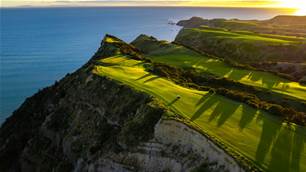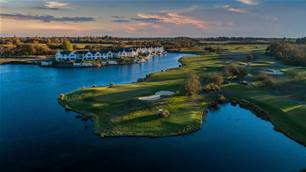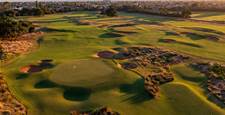The past 25 years can rightly be dubbed Australia’s second ‘Golden Age’ of course design – and one of the first courses created in the era remains one of this country’s most fun and challenging layouts for everyone.
If you are looking for true links golf in the tradition of the great courses of Scotland and Ireland, you can satisfy your desires at The Dunes.
For good players in search of a stern challenge to test your game, you must play The Dunes.
If, like me, you’re not so wrapped up in what you score but want to experience the fun of trying to play crisp shots from a wide range of lies, you really have to play The Dunes.
And, even if you only on occasion break 100 at your local course, you are unlikely to better the century here but it will be the most fun you’ve had shooting triple digits.
It’s not hard to be impressed by The Dunes, because it is a course that can be enjoyed by players of all standards and for a variety of reasons.
Make no mistake, though, The Dunes can be a brute when the wind is blowing. But the beauty of Tony Cashmore’s design is that, despite what Mother Nature might deliver, the course remains fair and very playable for all.

In fact, it is this difficult marriage of fun and challenge some course architects struggle with and the result is a course that offers plenty of bite and little, if any, fun. Not Cashmore.
Opened for play in 1997, Cashmore’s work at The Dunes – arguably the best in a long career of course design – is always a joy to play. It is a test and it is fun, which is undoubtedly why on Victoria’s Mornington Peninsula – a golfing region boasting a plethora of star courses – The Dunes’ star burns as one of the brightest.
Cashmore’s marvellous creation sits in the area of the peninsula known as ‘The Cups’ and yields magnificent land for golf. The original slogan at The Dunes was entirely apt: “God made it, we just mow the grass.” But it was Cashmore who found the course among the sand dunes and the result is a collection of holes that weave towards all points of the compass, which ultimately adds to the enjoyment. In fact, only once during a round – at the 6th and 7th – do golfers play consecutive holes in the same direction.

Cashmore and Dunes’ owner Duncan Andrews changed two holes in 2012, utilising newly available land in one corner of the property. The new 15th and 16th holes, a par-4 and par-5, flipped the pars of the previous versions and took play through the new pocket of land in a more enterprising manner. The 15th was formerly a lacklustre par-5 and is now a strong par-4 boasting a green that has a unique sunken rear section that the surrounding contours work towards. The new 16th is now a par-5 and wraps around a huge blowout bunker on the left side of the fairway that frames the tee shot beautifully. Now nearly seven years old, the pair has bedded in nicely, so much so first timers wouldn’t know the difference between these holes and the 16 originals.
Cashmore certainly has a flair for designing great short holes, whether they be devilish par-3s or risk-and-reward par-4s. One of the best short two-shotters in his entire design portfolio comes early in the round at the 310-metre 4th hole. The fairway splits left and right around several mounds, with the right being punctuated by three deep bunkers and longer hitters need only carry their drive 225 metres over the sand to set up a short pitch onto the green. The more conservative left fairway route leaves a difficult-to-judge short iron approach into the green, which is guarded by five bunkers.

The Dunes has had its fair share of golfing champions walk its fairways during the past 22 years. In 2005, Jason Day won The Dunes Medal and later heralded the course one of his favourite courses in Australia.
Seven-time major champion Tom Watson was a visitor in its early days and he singled out the par-3 17th as a “truly beautiful golf hole.” It is a wonder that calls for either shot shape, depending on the wind and flag position, into a green perched above a collection of deep bunkers.
While Watson might rate the 17th as a beautiful hole, another par-3 will also inspire late in the round. Six-time major winner Nick Faldo has a preference for the 160-metre par-3 13th hole saying it “is certainly one of the best par-3s I have ever played.” The hole features a green almost totally surrounded by large dunes. High dunes to the left run the length of the hole and wrap around the back of the putting surface and serve to fool the player on the strength of the breeze blowing from the west or south-west. Bunkers right and left guard the large green, while a lone trap through the back ensures you take care with your club selection.

The bunkering is an unforgettable feature of any round at The Dunes. Some holes have wild rugged expanses of sand, others have sandy blowouts atop a dune, and then there are the well-placed deep pot bunkers, which are designed to intimidate and penalise bad shot-making.
Complementing Cashmore’s design is a high level of presentation that has barely waivered over two decades. The Santa Ana couch fairways – given the deep sandy base on which they lay – are, not surprisingly, terrific to hit off.
Likewise, the Penn A-1 bentgrass greens are outstanding. They are presented firm and roll very smoothly, which always adds to the enjoyment of a round at The Dunes – no matter what the conditions.
THE COURSE
ADDRESS: Browns Rd, Rye, Victoria 3941.
CONTACT: (03) 5985 1334.
WEBSITE: www.thedunes.com.au
DESIGNER: Tony Cashmore (1997).
PLAYING SURFACES: Santa Ana couch (fairways, tees); Penn A-1 bentgrass (greens).
COURSE SUPERINTENDENT: Simon Muller.
PGA PROFESSIONAL: Gavin Coyle.
GREEN FEES: $65 (weekdays), $85 (weekends). The nine-hole Cups course is $25 (seven days).
THE CLUB
MEMBERSHIPS: Membership is currently closed.
RANKING: No.9 in Golf Australia’s Top-100 Public Access Courses in Australia, 2019; No.27 in Golf Australia’s Top-100 Courses in Australia, 2018.
Related Articles

Course Review: Cape Kidnappers

Drinks With... Ricky Ponting








_15th_hole.jpg&h=115&w=225&c=1&s=1)




